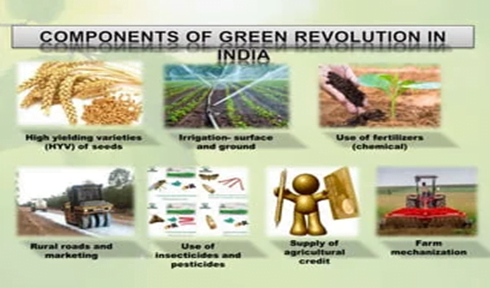Economics, Governance
Context: India is on the fast track to promoting eco-friendly modes of transportation with a growing emphasis on hybrid and electric vehicles.
About Green Resolution:

- The production of food within India was insufficient in the years from 1947 to 1960 as there was a growing population, during which famine was also anticipated.
- Many farmers were in debt, and they had become landless laborers.
- There was a severe shortage of food crops as well as commercial crops.
The Green Revolution:
- In India, the green revolution was launched under the guidance of geneticist Dr. M. S. Swaminathan.
- The Green Revolution was a period that began in the 1960s during which agriculture in India was converted into a modern industrial system by the adoption of technology, such as the use of high-yielding variety (HYV) seeds, mechanised farm tools, irrigation facilities, pesticides and fertilizers.
Primary aim:
- The green revolution’s primary aim was to introduce high-yielding varieties (HYVs) of cereals to alleviate poverty and malnutrition.
Benefits of Green Revolution
- There are undoubtedly positive effects on the overall food security in India.
- The Green Revolution within India led to an increase in agricultural production, especially in Haryana, Punjab, and Uttar Pradesh.
- Increased food production: The Green Revolution led to a considerable increase in food production, which helped in improving food security in India.
- Boosted economy: The movement helped to boost the Indian economy, with increased agricultural production contributing to economic growth.
- Reduced poverty: The Green Revolution in India contributed to a reduction in poverty, particularly in rural areas. Hence, it helped improve the standard of living for farmers.
- Increased employment opportunities: The revolution created new employment opportunities in agriculture and related industries, which helped tackle unemployment.
- Self-sufficiency: The Green Revolution helped India to become more self-sufficient in food production, reducing the country’s dependence on other countries for food.
- The green revolution led to the high productivity of crops through adapted measures, such as:
- Increased area under farming,
- Double-cropping, which includes planting two crops rather than one, annually,
- Adoption of HYV of seeds,
- Highly increased use of inorganic fertilizers and pesticides,
- Improved irrigation facilities, and
- Improved farm implements and crop protection measures.
Criticisms of Green Revolution:
Water-intensive crops:
- The crops introduced during the green revolution were water-intensive crops.
- About 3,500 litres of water is needed to produce one kg of rice, compared to 1,350 litres for wheat and 900 litres for maize.
- To take Punjab’s example, the state extracts 28 billion cubic metres (bcm) of groundwater annually, while its annual recharge is 19 bcm, which is unsustainable.
- Tube wells have to dive deeper and deeper to find water.
Imbalanced and unsuitable production:
- Punjab, Haryana and west Uttar Pradesh were chosen or led to produce wheat and rice for the nation.
- These states were relatively suitable for wheat, but not rice.
- The best states for rice were West Bengal, Odisha, Bihar and Assam.
- The three northern states were incentivized for growing rice along with wheat because they had good irrigation, unlike the eastern states which were largely rainfed.
Soil pollution:
- Chemicals have swallowed the soil’s innate nutrients.
- There has been a significant increase in the usage of pesticides, and India became one of the largest producers of pesticides in the whole of Asia.
Air pollution:
- Air pollution introduced due to the burning of agricultural waste is a big issue these days.
- In the heartland of the green revolution, Punjab, farmers are burning their land for sowing the crops for the next cycle instead of the traditionally practiced natural cycle.
Extinction of Indigenous Varieties of Crops:
- Since the time of the green revolution, there was reduced cultivation of indigenous varieties of rice, millets, lentils, etc.
- In turn, there was increased harvest of hybrid crops, which would grow faster.
- Due to the green revolution, India lost almost 1 lakh varieties of indigenous rice.
Health Impacts:
- Indiscriminate pesticide usage has led to several health effects in human beings in the nervous, endocrine, reproductive, and immune systems.
Way Forward:
- Crop Diversification:
- Agriculture in green revolution states cannot be saved unless a substantial part of rice cultivation is moved from there to eastern states.
- States want to diversify to other crops, but they do not want their income to fall in the process.
- It can be done only when the State builds robust ecosystems for alternative crops as it had done for rice and wheat.
- Climate-resistant crops:
- Addressing the challenges like water and air pollution would require agricultural production focussed on the water-energy nexus, making agriculture more climate resistant and environmentally sustainable.
- Technological interventions:
- Wider use of digital technology and extension services will be helpful in information sharing and generating awareness among the farmers.
- Need of Green Revolution 2.0:
- India needs a second green revolution along with the next generation of reforms with a view to make agriculture more climate-resistant and environmentally sustainable.
- Supply-side interventions:
- The need is supply-side interventions such as higher public investment, storage infrastructure and promotion of food processing.
Source: All India Radio













